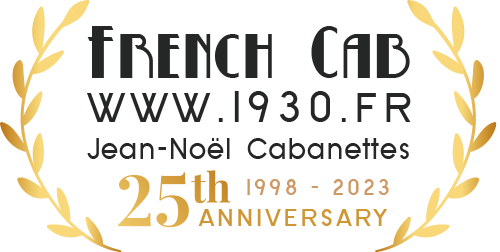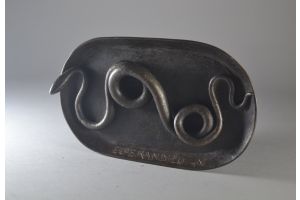Victor Esperendieu wrought iron pin tray with snake. Brandt Era.
Victor Esperendieu (1878-1952)
( "Best workers" in France in ironwork awarded for the first time in 1924. He also participated in the International Colonial Exhibition of Paris in 1931.)
Wrought iron pin tray.
Dark patina.
Signed.
Circa 1920.
16cm 9.5cm
Victor Adrien Espérandieu, son of a postman, was born in Salon-de-Provence on March 6, 1878. He began beating iron at the age of twelve in a forge in his hometown with a staggering balance of two francs per month. In 1892, at the age of fourteen, he left Salon to head to Paris where he stayed for seven years learning the trade and working relentlessly. Back home, he worked in a blacksmith shop. He was proclaimed the first ironworker in France in 1904. A fierce worker, always looking for work and improvement, he still finds the strength, every Sunday, to build all alone a large bastide in Salon, located in Faubourg Saint-Côme of which he was the architect, the mason, the roofer, the carpenter, the ironworker… He took five years to build his “Tour de Nesle”, as he liked to call it with all his romantic fervor.
When world war I arrived, Espérandieu was assigned to Auvergne as a soldier, then a metalworker in a war factory folded to Brioude (Haute Loire) where he met his future wife Marie Lespinasse. Victor and Marie formalized their union at the town hall of Brioude on June 5, 1920 and settled at 9 rue de la Chévrerie. At this time Espérandieu set out on his own and set up his forge in the village with the only help from his nephew by marriage René Lespinasse and a Spanish boarder, José Giménez, fitter. He works in the old fashion with the reduced tools of the ironworkers of yesteryear. Little by little he accumulated laurels: honorary prize at Vichy and interdepartmental labor exhibition in 1924; one of the first best workers in France in ironwork awarded for the first time in 1924. He also participated in the International Colonial Exhibition of Paris in 1931. At the beginning of the 1930s, he built and moved into a house at number 74 of rue Saint Esprit (today no. 20) where he also had his forge. Espérandieu admitted to his friends that he would have liked to be a sculptor. He loved things in nature and he enjoyed reproducing in iron foliage, flowers, insects, birds, butterflies... the ironworker of nature according to his contemporaries. His work was very diverse: monumental grilles, furniture, lighting…He donated these works to the Musée du Travail in Paris, to the town hall of Salon-en-Provence and that of Brioude, whose monumental portal from 1924 earned him the title of Meilleur Ouvrier de France. His house-workshop in Brioude still preserves numerous pieces made by Espérandieu, including the grille of the entrance gate. He died in Brioude of a heart attack on August 2, 1952. Today, a rue Victor Espérandieu bears his name in his hometown and a Plan Square in his adopted town in Brioude.
( "Best workers" in France in ironwork awarded for the first time in 1924. He also participated in the International Colonial Exhibition of Paris in 1931.)
Wrought iron pin tray.
Dark patina.
Signed.
Circa 1920.
16cm 9.5cm
Victor Adrien Espérandieu, son of a postman, was born in Salon-de-Provence on March 6, 1878. He began beating iron at the age of twelve in a forge in his hometown with a staggering balance of two francs per month. In 1892, at the age of fourteen, he left Salon to head to Paris where he stayed for seven years learning the trade and working relentlessly. Back home, he worked in a blacksmith shop. He was proclaimed the first ironworker in France in 1904. A fierce worker, always looking for work and improvement, he still finds the strength, every Sunday, to build all alone a large bastide in Salon, located in Faubourg Saint-Côme of which he was the architect, the mason, the roofer, the carpenter, the ironworker… He took five years to build his “Tour de Nesle”, as he liked to call it with all his romantic fervor.
When world war I arrived, Espérandieu was assigned to Auvergne as a soldier, then a metalworker in a war factory folded to Brioude (Haute Loire) where he met his future wife Marie Lespinasse. Victor and Marie formalized their union at the town hall of Brioude on June 5, 1920 and settled at 9 rue de la Chévrerie. At this time Espérandieu set out on his own and set up his forge in the village with the only help from his nephew by marriage René Lespinasse and a Spanish boarder, José Giménez, fitter. He works in the old fashion with the reduced tools of the ironworkers of yesteryear. Little by little he accumulated laurels: honorary prize at Vichy and interdepartmental labor exhibition in 1924; one of the first best workers in France in ironwork awarded for the first time in 1924. He also participated in the International Colonial Exhibition of Paris in 1931. At the beginning of the 1930s, he built and moved into a house at number 74 of rue Saint Esprit (today no. 20) where he also had his forge. Espérandieu admitted to his friends that he would have liked to be a sculptor. He loved things in nature and he enjoyed reproducing in iron foliage, flowers, insects, birds, butterflies... the ironworker of nature according to his contemporaries. His work was very diverse: monumental grilles, furniture, lighting…He donated these works to the Musée du Travail in Paris, to the town hall of Salon-en-Provence and that of Brioude, whose monumental portal from 1924 earned him the title of Meilleur Ouvrier de France. His house-workshop in Brioude still preserves numerous pieces made by Espérandieu, including the grille of the entrance gate. He died in Brioude of a heart attack on August 2, 1952. Today, a rue Victor Espérandieu bears his name in his hometown and a Plan Square in his adopted town in Brioude.
REFERENCE: es0611









